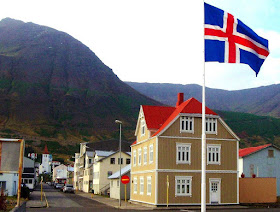Iceland is a country in progress. From a remote half-unknown island, a desolate treeless land of volcanoes, canyons, torrents and waterfalls with a few small fishing villages along the coast, Iceland has been changing rapidly into a modern country where the savage Nature is a plus to civilization; the coastal settlements are now coulourful and pretty, culturally eventful, displaying all modern comfort and facilities.
The island's circular road has been improved with tunnels, so that travelling is also easyer. This region of the extreme North, where Akureyri is the main thriving town, offers some of the best landscapes and attractive villages.
In the northern coast of Ireland, just a few miles south of the Arctic Circle and west of the large Eyja fjord, Siglufjörður is an old small fishing town that has become recently seeked for thanks to the viewing of Auroras - it's a privileged viewing point, and visitors from all the world are coming for the show.
Siglufjörður was inaccessible by road until 1940, but can now be reached via new tunnels linking to the main northern road, and has been improved with museums, cafés and a few shops, a new hotel and modern restaurants. All that, keeping alive the traditional fishing activities.
A string of tunnels now allows access from/to the East.
Siglufjörður is located on the left bank of its own narrow fjord, and surrounded by steep mountains.
A scenic little arctic town
Siglufjörður, northern Iceland
Coordinates: 66° 11′ N, 18° 53′ W
(22 km south of the arctic circle)
Population: ~1300
All these waterfront buildings from the old fisheries are now part of the Museum complex.
The town center: Museum, church, main street
Aðalgatan, the oldest street
Aðalgatan, from the shore to the church.
The modest but coherent church from 1890.
The church tower in late August
The local administration and the residents keep renovating some of the old houses, so the town looks almost brand new.
A typical Icelandic corner
The Sæbyhús from 1886, in Norðurgata - one of the oldest houses in town, now declared heritage.
An Icelandic beauty.
Henriksen house, the best house in town, in Aðalgata.
The magnificent house was built for a Norwegian herring trader. and is now a fine Hostel.
'Gistihús Soffía', also in Aðalgatan.
View from a window at Soffia's guesthouse
A small shop in Suðurgötu
Hjarta Bæjarins, Aðalgata - wool knitting, design, crafts and gifts
The port and leisure area
In the last century, the town experienced dramatic changes (that can be viewed in the Herring Museum). At one point, it was the busiest place in Iceland during summer and the center of the booming herring industry.
But the port keeps a strong local position for fishing cod, haddock, saithe, redfish, halibut, and also shrimp, flatfish, lobster. Freezing industry is also at full work, and Siglufjörður is still the largest cod landing port in Iceland.
The 'Júlíus Geirmundsson', a trawler from the local fleet.
The red, the yellow and the blue
Three fishing warehouses were converted for leisure and tourism as cafés, art galleries and other events. Each one painted in a different (bright) colour.
Hannes Boy café
Behind the Rauðka (red) and the yellow, there is the Bláa (blue) house
Jolamarkadur - the Yuletide Market
Christmas market Jólamarkaður
The Herring Era Museum
The Museum is installed since 1994 in warehouses that were part of an old Norwegian herring station. The assembly, construction and installation of the Museum was completed in 2003.
The three exhibit buildings tell the stories of the people who worked in the herring industry, of the factories and products, and of the fishing work and fishing boats.
Museum Síldarminjasafnið (The Herring Heritage)
The three buildings are the Salthúsið (Salt house), the Grána fish processing house and the larger boat house Bátahúsið.
The main building is a salting station from 1907. In front there is an old pier with work stations for the salting process
The fish processing provided herring to export to Europe and North America in the form of fish meal for feed and fertilizer; and fish oil, for use in all manner of household products, from floor wax to hair cream.
Grána fish factory, 1930-50
Products from the factory
The Boat House displays boats and trawlers, equipment and scenes of the daily fishing life.
"Herring ball in Siglufjörður" (1918) by Muggur, in the Herring Museum.
The Boat House reflected on the waters of the fjord.
The Folk Music Center
When visiting the Folk Music Center guests get an idea about Icelandic folk music, hearing local people singing traditional rhymes and folk songs.
The Folk Music Centre in another of Siglufjörður’s oldest houses, the Madame House (Maðdömuhús,1884).
The Icelandic Poetry Center, "Ljóðasetur islands":
http://ljodasetur.123.is/
Ljóðasetur islands offers the opportunity to browse poetry books and experience live events.
A bookshelf of Icelandic literature
The Siglufjörður Hotel
In summer, an outdoor café
Warm interior, Nordic design at its best.
Also a warm outdoor pool with a view.
Skarðdal forest, at 66° 8' N
A program of forestation has been developed at Skarðalur, near Siglo; the forest 'opened' in 2015, and it's the northernmost planted forest in Iceland, reaching Arctic latitudes. Mainly birch, spruce, pine and larch have been planted, and the system reached a development allowing for leisure, with nature paths for visitors.
The fiord forest in glorious spring.
Finally, some Aurora fotos from Siglufjörður and surroundings:
What a wonderful, magic place this is, don't you agree ?




































































Norway is cool I guess, but too misty and foggy for me. I think England is less foggy than this.
ReplyDeleteThis is no Norway, Twister. It's Iceland.
ReplyDeleteAnd please don't say 'whatever'.